|
< Earlier Kibitzing · PAGE 3 OF 3 ·
Later Kibitzing> |
| Oct-31-09 | | zanshin: <der623: I invite anyone to tell me where White's compensation lies after Black plays 22...Q:b2 after which White is going to lose either the C pawn or A pawn.> I agree with <guaguanco>. After <22...Qxb2??>, the check wins the game. 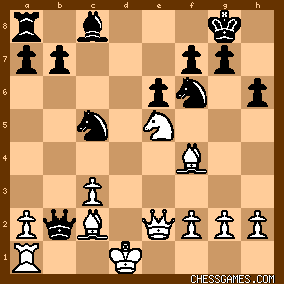
click for larger view |
|
| Oct-31-09 | | yalie: <yalie: Didnt get it. I went for tying up the knight with 39. Be1 axb cxb Rc8+ Kb2 Nc1 Rd2 e5 Bf2 f5 Bxb6, which looked real good to me.> can someone please refute this plan for white? It still looks good to me. |
|
| Oct-31-09 | | Once: An odd week where I mostly got each day's solution ... with the exception of Tuesday! Today is a goldilocks sort of position. White is looking for a queening square, but which one to choose? Well first we think about a8, with the idea of pushing the rook away, playing ba and then pushing the a pawn through to coronation. But when goldilocks tried this, it was too hard. The Ra8 is hard to shift and ba is way way too slow. Time to think again. Next Goldilocks tried c8, with the idea of c5-6-7 and Rd8+. But this was too slow and too risky. Black has lots of scary moves, such as ab, Rc8 and Nb4+. Time to try another one. Then Goldilocks spotted the bishop sitting quietly on g3, with its gaze fixed firmly on b8. The black rook wouldn't be able to land there, and it would be harder for the black knight to reach. So then she looked at 39. c5! with the idea of either 39...bc 40. b6 or 39...ab 40. cb. In either case, a white pawn lands on b6, with b7 covered by the white rook and b8 covered by the Bg3. And Goldilocks decided that this move was just right. Naturally, she hadn't seen Rc8 as a defence, but then she is only young and this is a fairy story ... This episode reminds me of a hoary old position, which I am sure you have seen many times before: 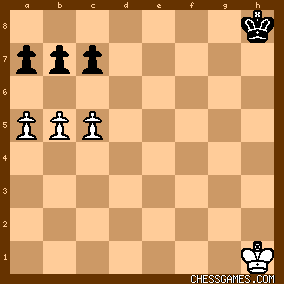
click for larger viewWhite breaks through with 1. b6 ab (cb also fails) 2. c6! 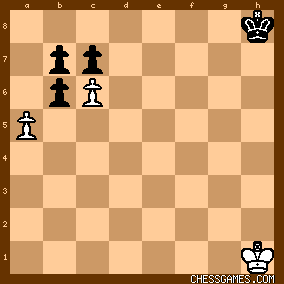
click for larger viewAs in today's puzzle, Black has a choice of pawns to capture, but cannot prevent the other one from running through to queen. Continuing on from our theme of "unusual powers of a pawn", this shows us the breakthrough potential of putting two pawns en prise at the same time. |
|
| Oct-31-09 | | sethoflagos: Looks like white needs to remove Pb6
Brute force attempt 39. Bc7 axb5 40. cxb5 Nb4+ Kb3 41. Nd5 Rd8+ 42. Rxd8 Bxd8 with nothing better to come than 43. .. Bxb6? 44. Nxb6 and I see no way of K forcing the b pawn past the knight. 39. c5 looks more promising but complicated. 39 .. axb5 40. cxb6 and 39 .. bxc5 40. b6 and the well protected passed pawn probably spells doom for black 39. .. Rc8 40. Rc7 Rxc7 41 Bxc7 and again black can't stop a passed pawn on b6. I presume knight checks are futile but sometimes life's just too short ... |
|
| Oct-31-09 | | CHESSTTCAMPS: In this endgame, white is down a pawn, but the white rook and the long-range bishop are ideally positioned to help the ascending white pawns, whereas the too-slow black knight (now remote from the action) and rook do not coordinate well in an open position. The black king is within the square of the c-pawn, so it can be factor in the defense if white is not careful, but the king is more of a liability because it is vulnerable to tempo-gaining back-rank checks from the rook that help a pawn promote. And make no mistake about it, black is on defense and will never get a chance to mobilize the kingside majority, because white is capable of creating a passed pawn on the a-file, b-file, or c-file, a flexible circumstance that makes the defense impossible. This summary should make the move obvious - white must immediately force creation of a passed pawn with 39.c5!
Starting with the weaker defenses (pawn captures) first: A) 39... bxc5 40.b6 Nb4+ 41.Kb3 Nc6 42.b7 Re8 43.Rc7 Nb8 44.Rc8 Kf8 45.Bd6+ wins A.1) 40... Re8/f8 41.b7 transposes to other A lines
A.2) 42... Ra7 43.b8=Q+ Nxb8 44.Rxa7 wins
A.3) 42... Rf8 43.Bd6 Re8 44.Rc7 Nb8 (Nd4+ 45.Kc4 followed by Rc8) 45.Rc8 wins A.3.1) 44... Rb8 45.Rc8+ wins
B) 39... axb5 40.cxb6 is similar to the A lines except black has the useless option 40... Rc8+ 41.Kb2 Nb4 42.b7 winning faster for white. C) 39... Rc8 40.Rc7! (simplest - not c6? Kf8 41.c7 Ke8) Rxc7 41.Bxc7 bxc5 42.b6 (bxa6?? Nb4+) Nb4+ 43.Kb3 Nc6 44.b7 Kf8 45.b8=Q+ Nxb8 46.Bxb8 Ke8 47.Kc4 Kd7 48.Kxc5 a5 49.Kb5 a4 50.Kxa4 Kc6 51.Kb4 Kd5 52.Kc3 denies the black king entry to the white pawn position, with an easy win. C.1) 40... Rb8 41.c6! Nb4+ 42.Kb3 a5 43.Rb7 Rc8 44.c7 Kh7 45.Rb8 wins C.1.1) 42... Nd5 43.Rb7 Rc8 44.c7 Kh7 45.bxa6 wins
C.2) 40... Rd8/c8 41.cxb6 transposes to A.
C.3) 41... axb5 42.cxb6 Nb4+ 43.Kb3 Nc6 44.b7 wins
D) 39... Kf8 40.cxb6 Ke8 41.b7 Rb8 42.Bxb8 Kxd7 43.Bd6 wins D.1) 40...Rc8+ 41.Rc7 wins
E) 39... Nb4+ 40.Kb3 Nd5 41.Rxd5! exd5 42.cxb6 and that pawn can't be stopped. E.1) 40...a5 41.cxb6 transposes to A
Time to verify... |
|
| Oct-31-09 | | CHESSTTCAMPS: <TheBish:>
<C) 39...Rc8! (best defense) 40. Rc7!> Nice - I did a quick check to see if anyone else chose this. I first looked at the continuation that turned out to be Rublevsky's selection, but I thought this was clearer. |
|
| Oct-31-09 | | WhiteRook48: I tried 39 Rd8+ to get passers... |
|
| Oct-31-09 | | David2009: Saturday's puzzle Rublevsky vs A Volzhin, 1995 White 39? White is a Pawn down with B for N. I am theorising from a diagram without having seen the game, but I strongly suspect that Black's last move was a6
(no doubt to protect his N which was however in no real danger). If so 38...a6 was a blunder which merely
encourages/empowers White to play 39 c5!
This sort of move is either very good or very bad. Here it is good (see analysis below): it works because White's B controls c7 and b8. It would have simply lost a Pawn with a Black Pawn still on a7.
Meanwhile Black's N can get back in the game via b4 and c6 or perhaps a6: can this save him? Enough theorising, time for some concrete variations. After 39 c5 Black can choose between:
Line A: 39... bxc5 40 b6 Nb4+ 41 Kg3 Nc6 42 b7 Re8 43 Rc7 and wins.
Line B: 39...axb5 (freeing a6 for the N) 40 cxb6! Nb4+ 41 Kg3 Na6 (or 41 ... Nc6 42 b7 etc as line A) 42 Ra7!
winning everything.
Time to check and also see if I am right that 38 ...a6? was
played.
=====
Well I was right about 38...a6? but missed Black's actual defence. One out of two ain't bad. |
|
Oct-31-09
 | | Jimfromprovidence: This is a very difficult puzzle.
I got 39 c5 Nb4+ 40 Kb3 bxc5 41 b6 Nc6 42 b7 Na5+ 43 Kc3 Nxb7 44 Rxb7 as the best defense.
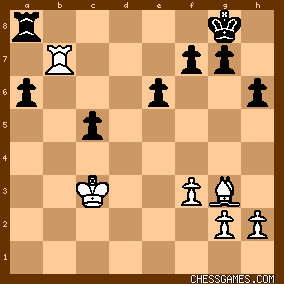
click for larger view
The c pawn looks lost and the f pawn is under attack so the king can’t move. Now, if black plays something like 44 …Rd8, white can play 45 Rb8, forcing the rook exchange. Then he can pick up the a and c pawns.
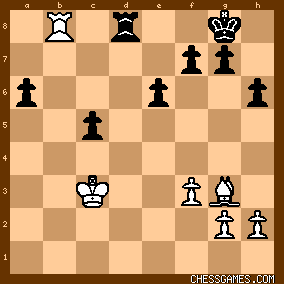
click for larger view |
|
| Oct-31-09 | | ComboKal: Wow! After the fork with the knight at <40. ...Nb4+>, I thought for sure that black would follow up with <41. ...Nxa6>, but white then plays <42. cxb6>. I didn't play it out in my head that far because I had it in the back of my mind that the c pawn was still pinned. No matter what, white gets the passed pawn! |
|
| Oct-31-09 | | David2009: Rublevsky vs A Volzhin 39? 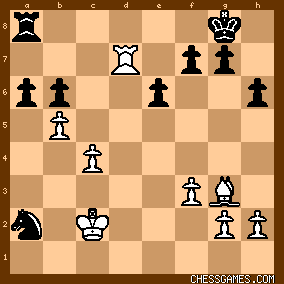
click for larger view
My analysis Rublevsky vs A Volzhin, 1995 misses an additional defence: 39 c5 Ng4+ 40 Kg3 (to presssurise the N) bxc5 41 b6 Nc6 42 b7 Na5+
43 Ka4 Nxb7 and Black has three Pawns for the piece but unfortunately cannot prevent the Rook exchange after which
the ending should be lost. But White has to be careful. I win against Crafty but I am not sure Crafty always finds the best plan. Try it yourselves for winning practice:
http://www.chessvideos.tv/endgame-t... In the game line (the defence 39...Rc8 I missed), Crafty prefers 42...Nc3 43 Bb8 Nxa7 44 Bxa7 h5 45 Rb7 Rd1+ 46 Kb3 preparing
Rb2 to defend the second rank. Crafty finds interesting resources in the position, but the end result should not be in doubt. Second Crafty link for winning practice: http://www.chessvideos.tv/endgame-t... I have not yet read all the other kibitzes - apologies if some of this merely repeats lines others have already posted. |
|
Oct-31-09
 | | doubledrooks: <yalie> wrote: <Didnt get it. I went for tying up the knight with 39. Be1 axb cxb Rc8+ Kb2 Nc1 Rd2 e5 Bf2 f5 Bxb6, which looked real good to me.>
<can someone please refute this plan for white? It still looks good to me.> I went for this line, too. Also, if 39...a5 40. Kb2 Nb4 41. Bxb4 axb4 42. Rb7 and white emerges with two connected passed pawns. |
|
| Oct-31-09 | | Criswell: <lost in space: Haven't got it. I tried to trap the Na2 with 39...Bd6.
I will now try with the help of Rybka, if this is working out or not.> I thought the same thing but after either 39. Bd6 or 39. Be1 Black simply replies 39. ...a5! making the knight untrappable. |
|
| Oct-31-09 | | tacticalmonster: 1)white is down a pawn
2)black knight is on the edge of the board
3)white rook is on the seventh rank
4)bishop vs knight with rooks ending
5)white king is an active fighting piece while black king is shut out
6)white queenside pawns are further advanced than black'swhite plan:
a) trap the black knight or
b) create a pass queenside pawn and promotes
candidate: Bd6 ( prevent escape route, stop kf8 and eyeball b8 square)
c5 ( create pass b pawn supported by rook and bishop) 1. Bd6 a5 followed by Nb4+ and sac the a pawn to go into a slightly worse rook ending for black 1. Bd6 axb5 2. cxb5 white has no way of exploiting the weak knight 1. c5 Nb4+ 2. Kb3 Nd5 3. Rxd5 exd5 4. cxb6 axb5 5. b7 Rd8 6.b8=Q Rxb8 7. Bxb8 1. c5 bxc5 2. b6 Nb4+ 3. Kc3 Nc6 4. Rc7 
1. c5 Rc8 2. Rc7 Rxc7 3. Bxc7 Nb4+ 4. Kb3 bxc5 5. b6 Nc6 6. Ka4 c4 7. b7 c3 8. b8=Q+ Nxb8 9. Bxb8 c2 10.Bf4  |
|
| Oct-31-09 | | CHESSTTCAMPS: <Jimfromprovidence:> <I got 39 c5 Nb4+ 40 Kb3 bxc5 41 b6 Nc6 42 b7 Na5+ 43 Kc3 Nxb7 44 Rxb7 as the best defense. > You are right - I missed this line. In fact, the position you diagrammed will reach the same ending (after the rook exchange, unavoidable for black as you correctly observed) that arises from 39... Rc8 40.Rc7 Rxc7 41.Bxc7 etc, in the solutions posted by yours truly and <TheBish>. |
|
| Oct-31-09 | | Artar1: My solution was a little different from what was actually played. I then checked my work using Fritz. <39. c5> White has sufficient force to create a pawn breakthrough. <39...Nb4+> Puts the weak knight back into play and fights for the initiative. 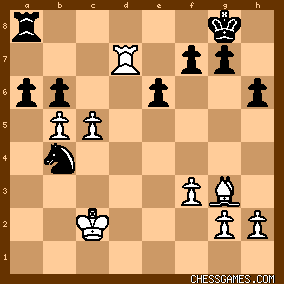
click for larger view<40. Kb2> Reduces the scope of the knight, leaving only <...Nd5> as the only playable move for that piece. <41...bxc5> My first inaccuracy. Reduces White's pawn force, but the remaining White pawn will cause Black to give up material to avoid queening. 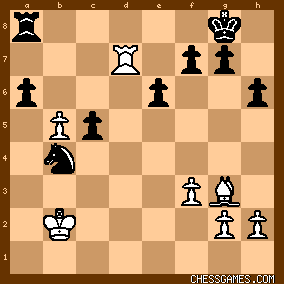
click for larger viewAccording to Fritz, better was <40...Nd5 41. Rxd5 bxc5 (41...exd5 42. cxb6 axb5 43. b7 Re8 44. b8=Q Rxb8 45. Bxb8 1-0) 42. Rxc5 axb5 43. Rxb5 Kh7> White should win the endgame. 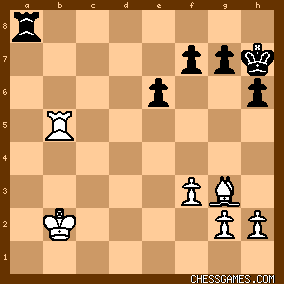
click for larger view41. b6 Nd5 (Fritz liked <41...Re8 42.b7 Nc6 43. Rc7 Na7 44. Kb3 Rb8 45. Kc4 h5 46. Bd6 h4 47. Kxc5 Rxb7 48. Rxb7 Nb5 49. Rb6> But this line only delays the inevitable. 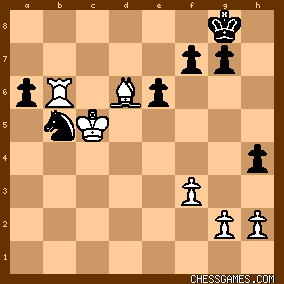
click for larger view<42. b7> Looks winning to me and is the solution I came up with using no board or computer. 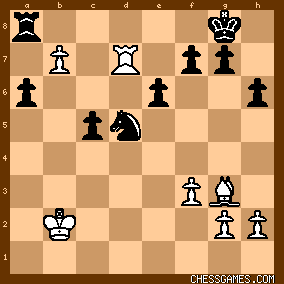
click for larger view |
|
| Oct-31-09 | | BOSTER: I guess that the pawns were very disappointed when somebdy here called them <cannon fodder>. And day after day are proving that the main actors in the chess only pawns.
The great Philidor was not so naive, when he said it is the pawns that form the basics of attack.
We sometimes underestimate the value of the pawn and do not understand , that the security of the pawns themselves is of paramount importance.
In today puzzle we can see "wiki" (quickly) the highway c5-b6-b7-b8 under surveillance Rd7 and Bg3 (only if black does not move).
Nevertheless ,39.c5 Rc8 40. Rc7 and white has winning position. |
|
Oct-31-09
 | | chrisowen: I muffed it totally trying the knight trap, white's game is head and shoulders above mine. The body of play is good and deserves a knees up. The prime responsibility lies in to get a threat, c5 does it adequatley cocking the hammer. |
|
| Oct-31-09 | | BEDRICH: 43 Bb8 decides c3+
44 Ke2 c2
45 Rd1 ++ |
|
| Oct-31-09 | | tacticalmonster: after 39. Rc8:
a) 40. Rc7? Rb8! 41. c6 axb5 42. Rb7 Rc8 43. c7 Nb4+ 44. Kb3 Nc6 45. Rb8 Na7! 46. Bf2 Rf8! 47. Bxb6 Nc8  b) 40. bxa6 Rxc5+ 41. Kb2 Ra5 42. a7 Kh7 43. Bb8! Nb4 44. Rd1 Nc6 45. Ra1 Rb5+ 46. Kc2 Nxa7 47. Rxa7  c) 40. bxa6 Nb4+ 41. Kd2 Nxa6 42. cxb6 Rc6 43. b7 Rb6 44. Rd8+ Kh7 45. b8=Q Nxb8 46. Rxb8  d) 40. bxa6 bxc5 41. a7 Nb4+ 42. Kd2 Nc6 43. Bb8! Nxa7 44. Bxa7  |
|
Oct-31-09
 | | Jimfromprovidence: <CHESSTTCAMPS> <In fact, the position you diagrammed will reach the same ending (after the rook exchange, unavoidable for black as you correctly observed) that arises from 39... Rc8 40.Rc7 Rxc7 41.Bxc7 etc, in the solutions posted by yours truly and <TheBish>.>
click for larger view
39 c5 Nb4+ 40 Kb3 bxc5 41 b6 Nc6 42 b7 Na5+ 43 Kc3 Nxb7 44 Rxb7 If we agree that the above line is strong defensively, then what should black do next? He should not waste a tempo moving his rook, because white can force a rook trade as long as his king has to defend the f pawn. Let’s assume that white trades rooks and will get the two pawns by playing the following representative line. 44…f6 45 Rb8+ Rxb8 46 Bxb8 Kf7 47 Kc4 e5 48 Kxc5 Ke6 49 Kb6 f5 50 Kxa6 g5.
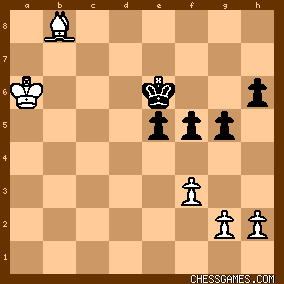
click for larger view
My knowledge ends here, but it looks like a win for white. |
|
| Oct-31-09 | | ComboKal: <BOSTER> re: <cannon fodder>. So true, the power of the pawn! Each one of them is a potential queen in as little as five moves. Once they are passed, their value increases dramatically. There is so much strategy involved in promotion or defending against promotion, yet this is just part of their function. They are defenders, blockers, attackers, as well as protectors of the king. Their very position on the board can change a game. It's been said that pawn structure is the "backbone" of a position. <Cannon fodder> ?? I couldn't find the reference here on any of these postings. Was it on a previous Kibitz? |
|
| Nov-01-09 | | Old Wolf: yalie I think your solution is good (I found the same one) Game line is better though :) |
|
Nov-01-09
 | | doubledrooks: <Old Wolf wrote><yalie I think your solution is good (I found the same one)
Game line is better though :)>
I thought so, too, but after seeing the positions in <JimfromProvidence>'s post above yours, it seems to me that 39. Be1 is at least as good as 39. c5. |
|
| Nov-02-09 | | CHESSTTCAMPS: <Jimfromprovidence> wrote on Oct 31 <<snip> If we agree that the above line is strong defensively, then what should black do next? <snip>> Sorry I didn't get to this yesterday. My initial reaction was to dodge your primary question by suggesting that white also can save a tempo from the 1st diagram after 44...f6 with 45.Kc4 instead of an immediate 45.Rb8+. In fact, if black continues to avoid trading rooks, white should win comfortably with 45.Kc4 Kh7 46.Rb8! Ra7 47.Kxc5 a5 48.Rb2 followed by Ra2 and some additional preparation to keep the black rook from getting to the 2nd rank after white wins the a-pawn. As for the 2nd diagram, I agree completely with your assessment that it's a win for white. Even with the white king apparently so far from the action, it's close enough. The basic technique is to approach with the white king, using the bishop to cut off the black king from the white pawn field and enforce opposition, then squeeze until the black king is forced away from defending pawns, similar to a K & P ending. So I see the following as a represent line of play: 51.Kg5 Kd5 52.Ba7 e4 53.fxe4 Kxe4 (fxe4 Be3 wins easily for white) 54 Kc4 f4 55.Bf2 f3 56.g3 (even with a pawn majority, black can't force pawn exchanges easily) h5 57.h3 g4 58.h4 Ke5 59.Kd3 Kd5 60.Bd4 Ke6 61.Ke4 and the white king wins all of black's pawns. 52... g4 53.fxg4 is not likely to fare better.
I hope this helps. |
|
 |
 |
|
< Earlier Kibitzing · PAGE 3 OF 3 ·
Later Kibitzing> |





